gunga
Flashaholic
For consideration for the reviews sub forum.
Portinga Products Firefly Second Prototype Review
Please note: This review will continue to evolve as I gather more data and pictures. I will continue adding to the review when possible. This prototype is stainless steel and utilizes a cool white XML2 LED. A titanium sample light (not a Firefly) has also been evaluated with the final production Nichia 219B (4000K colour temperature) LED. The final production Firefly will only be available in titanium.
This is a review of the second prototype of the Portinga Products Firefly flashlight, also known as the "Kickstarter Light". A sample was purchased for this review. No payment of any kind was accepted for the review.
Note: While this is considered a stand-alone review, large portions will be used from the review of the previous prototype, since many things have not changed.
The previous review can be found here:
http://www.candlepowerforums.com/vb...ype-Review-(the-quot-Kickstarter-light-quot-)
The current Kickstarter campaign can be found here:
https://www.kickstarter.com/project...ashlight-you-can-always-find-in-the?ref=users
More information on the creator, Josh Portinga, can be found here:
http://portingaproducts.com/
Summary
Overall, this is a an excellent light (prototype). The host is well machined with an innovative heatsink design for better heat shedding. The rectangular knurling is very grippy.
The milled clip is a work of art that clamps firmly and consistently.
The UI (User Interface) is simple and effective but a small adjustment in levels would improve the product (and is expected in the final production version).
The torch like tritium accents are both attractive and functional.
Here are some changes and improvements seen in the second prototype.
There are a few more changes to be incorporated into the final production version.
The creator (Josh Portinga) has been very responsive and creative in improving the light. The Firefly (second prototype) is already very good. The final production version should be exceptional.
Background
A brief origin story. The Firefly came out of the unsuccessful electric eraser campaign.
https://www.kickstarter.com/projects/2112614854/precision-cnc-machined-304-stainless-steel-electri?ref=nav_search
While that project did not meet its funding goal, conversations with one of the backers prompted the creator (Josh Portinga) to develop a high-end custom flashlight. It was thought that flashlights were obsolete due to the prevalence of smart phones with built in lights.
Well, while a smart phone has many uses, it will always be a compromise. Those who desire top performance, utility, or style, will still buy high end devices: Watches, cameras, and of course, flashlights.
Thus was born the Firefly.
Host Quality
The machining on the host is impressive. The knurling is a rectangular pattern that is both attractive and uncommon. It is also very aggressive. The knurling ensures that one should be able to keep a firm grip on the light in all conditions. That said, the final version will have the knurling softened somewhat to reduce damage to clothes and skin while still providing ample grip.
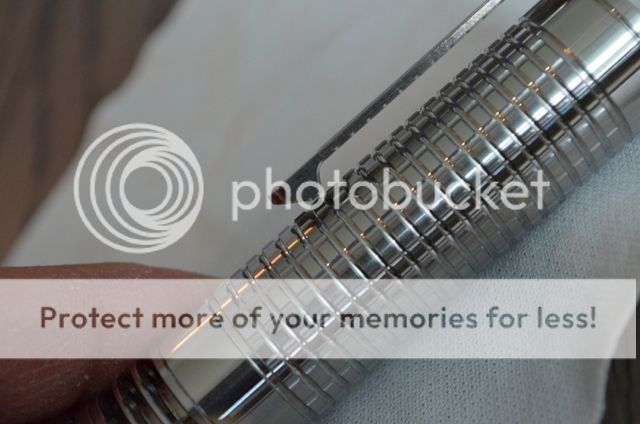
Here are some views of the light with the clip installed. Note the temporary clip hardware. The final product will thread directly into holes in the host (unlike the prototype, no backing nuts will be needed).
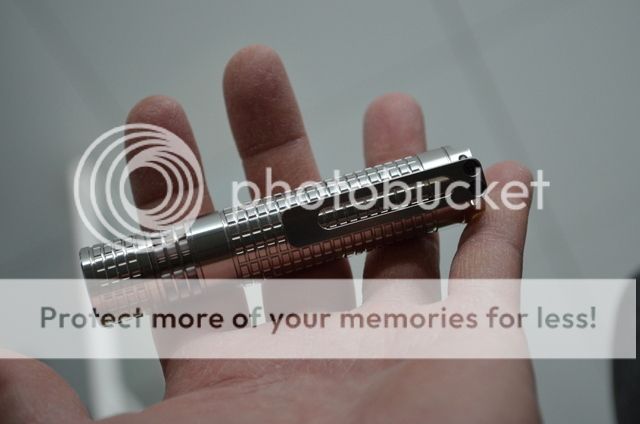
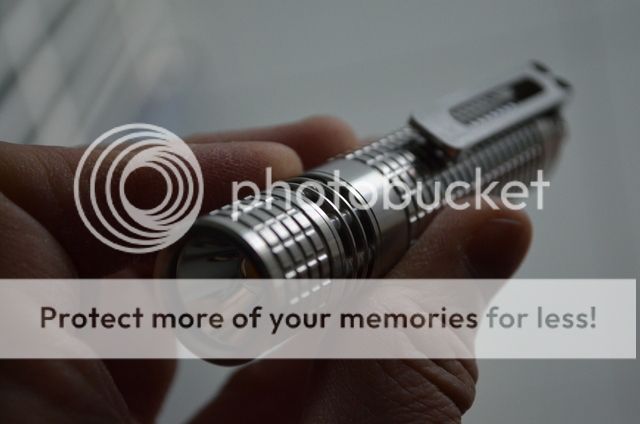
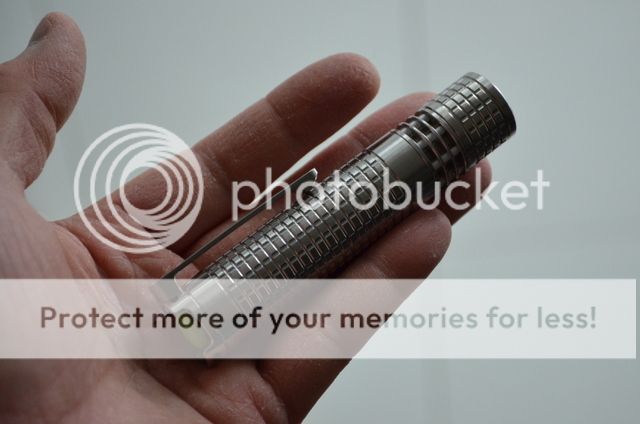
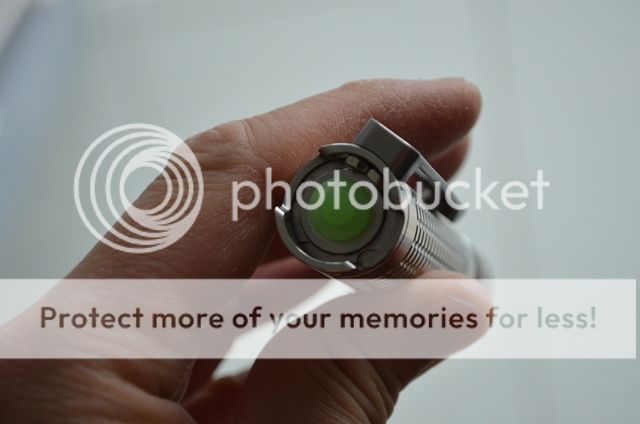
Note that I also tested the firefly with an alternative aftermarket clip out of interest. My clip hardware was worn out after some use (the temporary hardware loosened frequently) so an alternative clip was used.
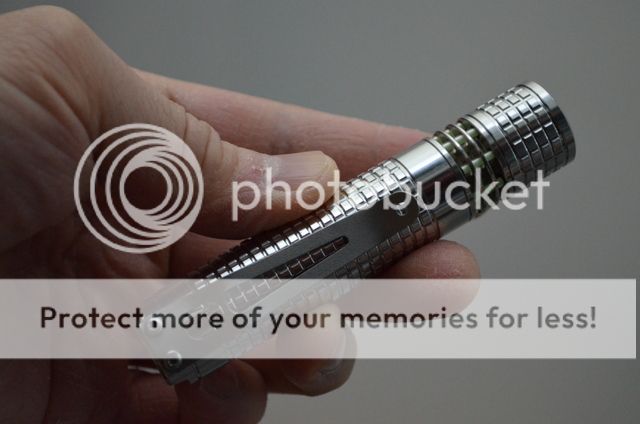
The threads were cut square and all pieces screwed together smoothly and precisely.
Here is the head partially disassembled. A nice, unique feature is that the LED thermal slug is soldered directly to the copper heatsink. This should promote great heat transfer to the host, keeping the LED nice and cool at high drive levels.
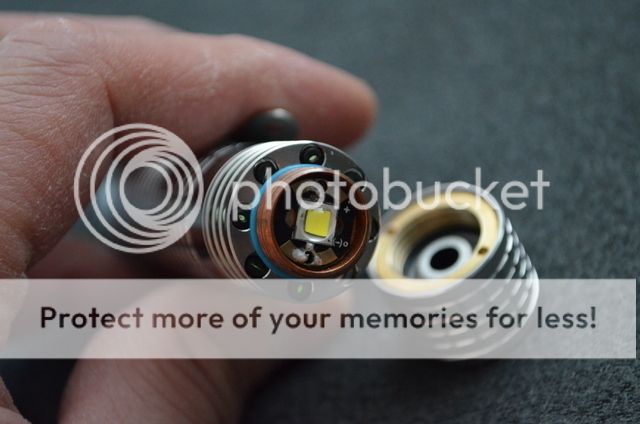
As you can see, the heatsink now incorporates a threaded brass ring that holds in the reflector in place. This ring allows the user to easily change or remove the tritium vials as needed. Please note the blue o-ring around the vials (for waterproofing).
Here is an alternate view with the ring removed from the head.
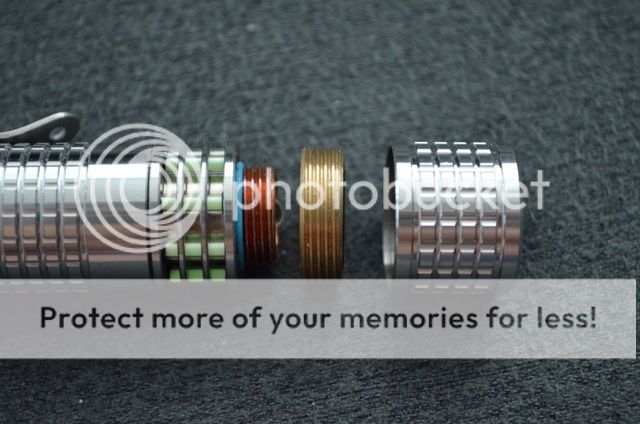
Here is a view of the heatsink with the brass ring and sealing o-ring in place.
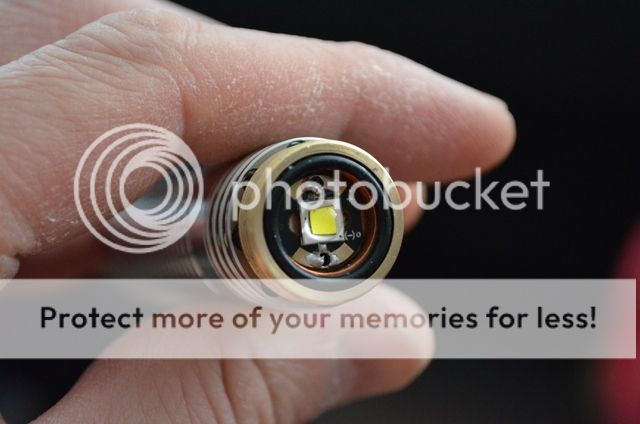
Yes, that is an AR coated lens.
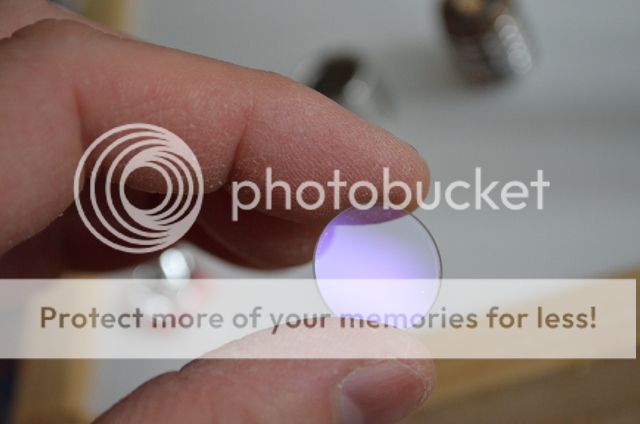
Overall, the host is very well put together and feels solid and hefty. Note that this prototype is stainless steel but the final production version will be constructed of Grade 2 titanium. Grade 2 titanium was chosen for its superior thermal conductivity.
Size-wise, the light is a comfortable 97x20mm. This should be considered a mid-size light, around the size of a many common AA lights (Fenix, Sunwayman, 4Sevens), but slimmer. It fits comfortably in the hand and is not too large to pocket.
This is the Firefly next to a Sunwayman M10A. Similar size to a Quark AA or Fenix equivalent.
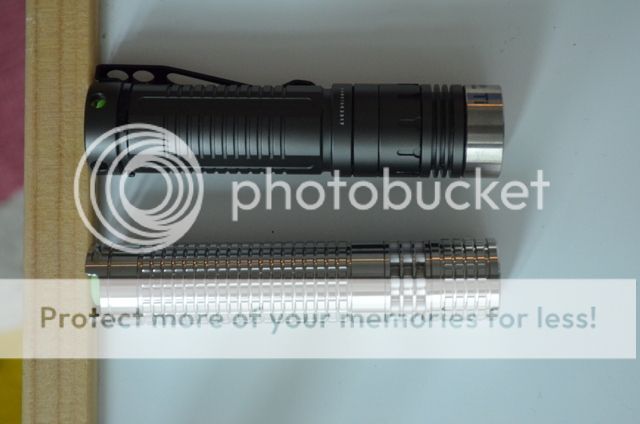
And next to a few common AA lights. So, from L-R: Olight S15R, Eagletac D25A, Firefly, Zebralight SC52w, Eneloop bettery.
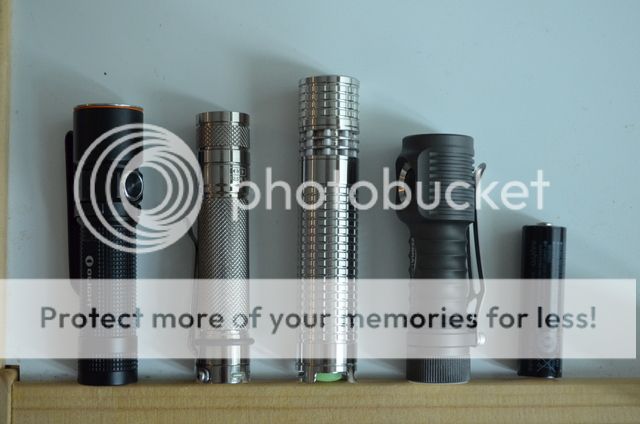
The switch boot cover is based on an uncommon size (10mm or so). I would have preferred a more standard size (14mm) but the switch worked well. The switch itself was a small Omten brand switch. They are reliable, easy to replace, and can handle high currents well (There are reports of usage up to 5 Amps). The switch is a reverse clicky, and the feel is firm and crisp.
Here it is next to a common 14mm boot. Note, the final production version will have a black boot.
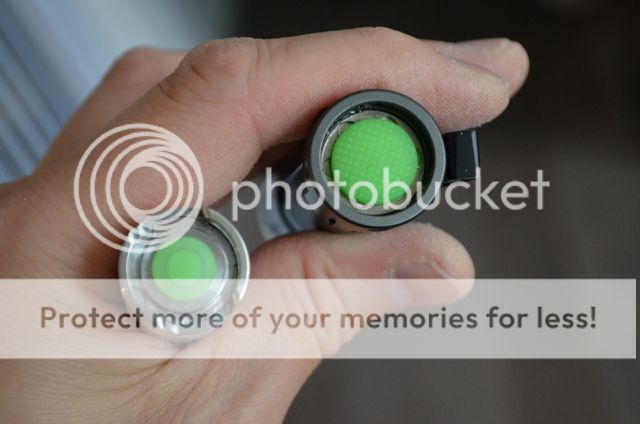
Clip Quality
The clip is quite a marvel, being both beautiful and functional. It is my first experience with a milled clip. The alloy is 6-4 (AKA Grade 5) Titanium with fantastic characteristics. The clip is very springy and firm. The strength of the clip coupled with the aggressive knurling on the light will ensure that it will not slip out of your pocket. It may, however, chew up the fabric of your pants. Keep this in mind in use.
Cosmetically, the clip is very elegant and unique. I do find it a bit large/wide for the light, but that is a matter of taste. The hardware (bolts and nuts) that came with the clip were temporary and did not function well (they loosened up frequently and were too small to secure the clip reliably). Interesting, the clip continued to function well even with the existing hardware.
The final version of the clip will be bolted directly into the body of the light and larger bolts are being incorporated to increase strength and rigidity. Also, the clip will be made narrower to better suit the size of the light.
Here are a few views of the clip on a dummy light body.
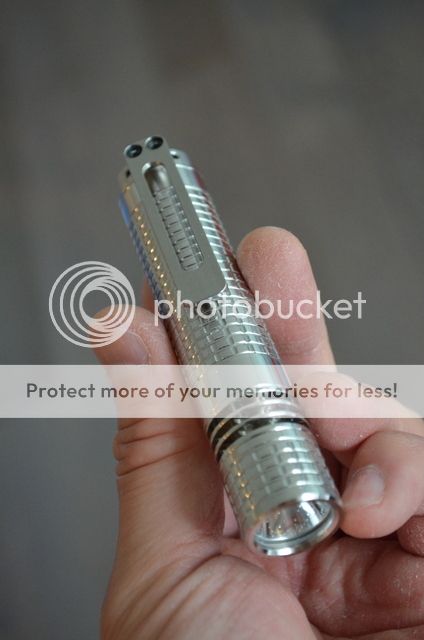
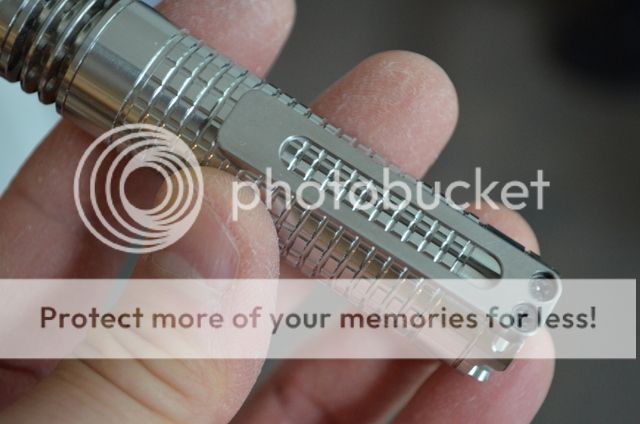
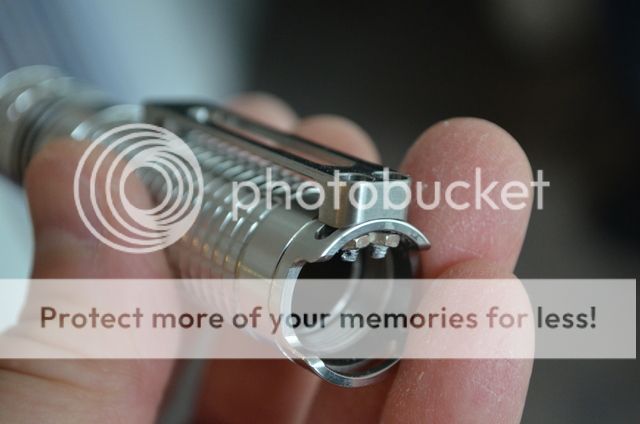
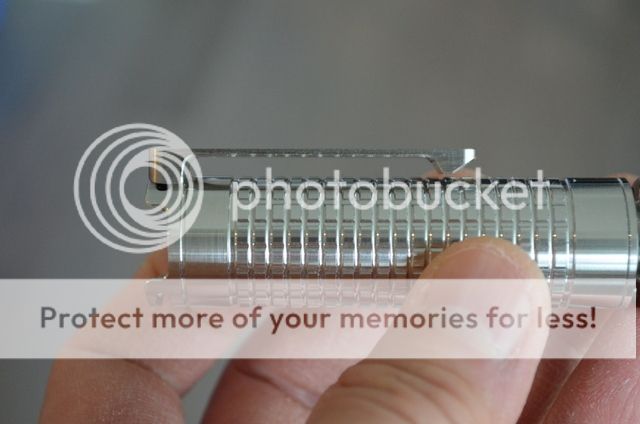
Beam Characteristics
The beam is a mixed bag. The smooth reflector is designed for a very wide spill and achieves this goal. While, overall, the beam is quite clean, I find the transition from spot to spill a bit abrupt. It may help with throw somewhat but I find makes close range use a bit less pleasant. That said, the spot is somewhat wide (it's definitely not a thrower).
Note that the final production reflector will be redesigned to be more floody.
The cool white LED is well centered in the smooth reflector.
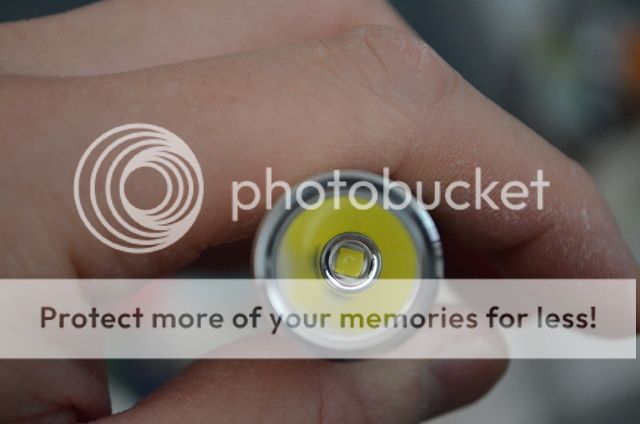
The beam is smooth but the hotspot is very distinct. Note that this is daylight colour balance but the beam is not quite that green in reality.
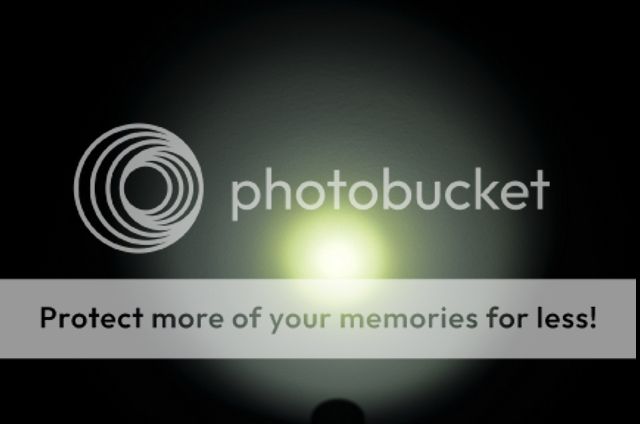
Here is a side profile of the beam.
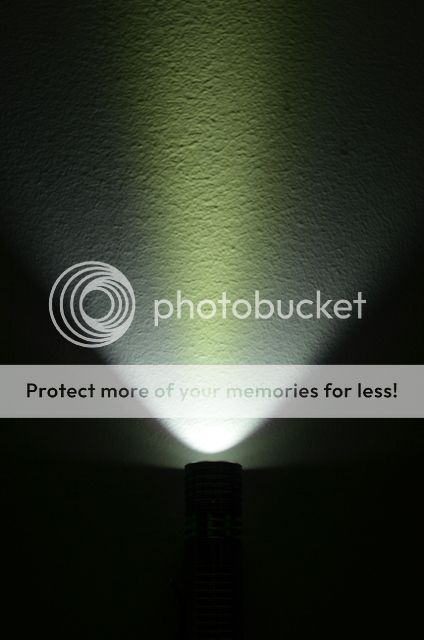
Alternative LED Choices and Titanium Host Sample
The Firefly will be offered in one of two LED choices:
1. Cool White XML2 (6500K tint) for maximum output
2. High CRI Nichia 219B (4000K tint) for best colour rendering.
A Titanium host from the machinist (The Luckysun Ti20) was evaluated to gauge the quality of the machining in titanium (very good) and the tint of the Nichia 219B LED (Also very good). A few pictures follow of the host. Note that a diffusion film was used on the lens to isolate beam characteristics from tint.
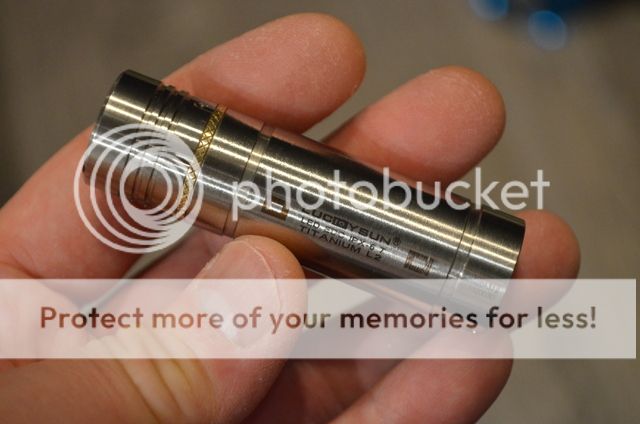
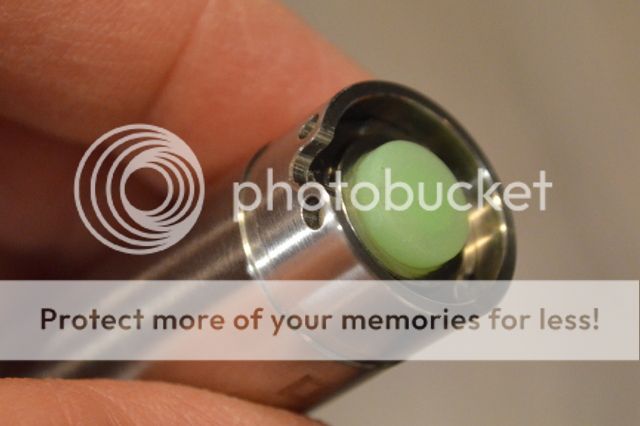
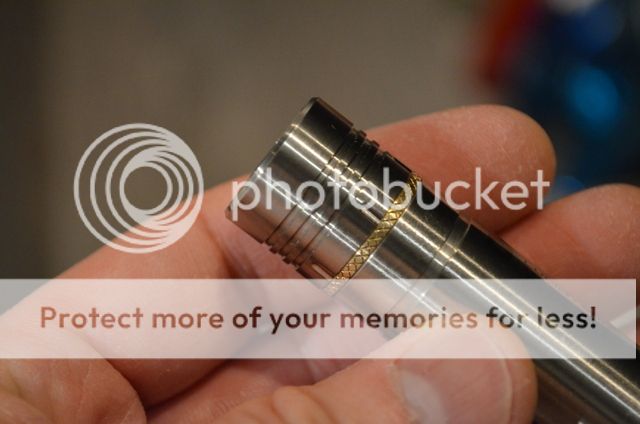
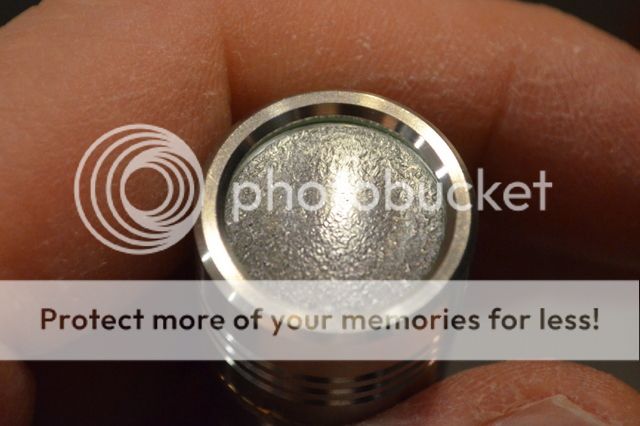
LED Characteristics and Tint
Pictures were taken with a Nikon D5100 SLR using daylight white balance. I attempted to replicate beam characteristics and intensity as much as possible but was only somewhat successful.
All the lights will have diffusion films over the lens to isolate tint from beam characteristics.
Here are descriptions and pictures of the tints to be compared. Note that differences in the Nichia tints are very subtle and hard to capture in pictures.
Here are the tints all together, from coolest (on the left) to warmest.
They are (from L-R): 1D XML2, Nichia 219C (5000K), Nichia 219B (5000K), Nichia 219A (4500K), Nichia 219B (4000K)

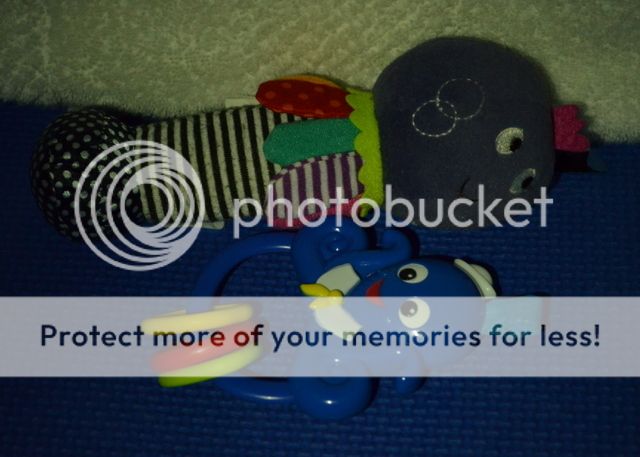
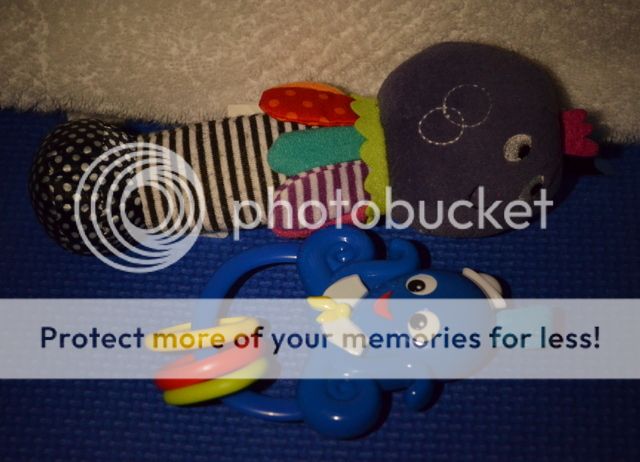
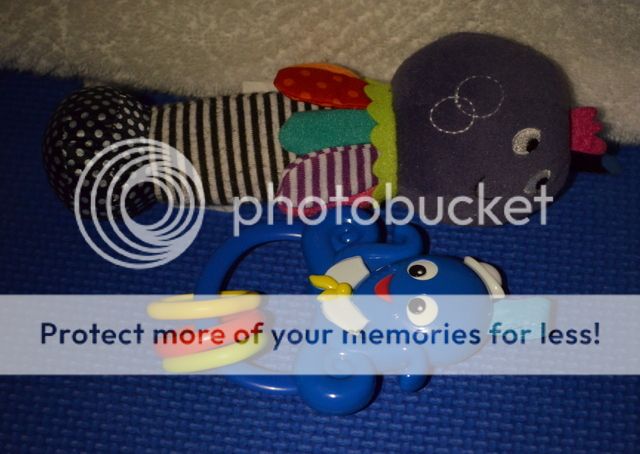
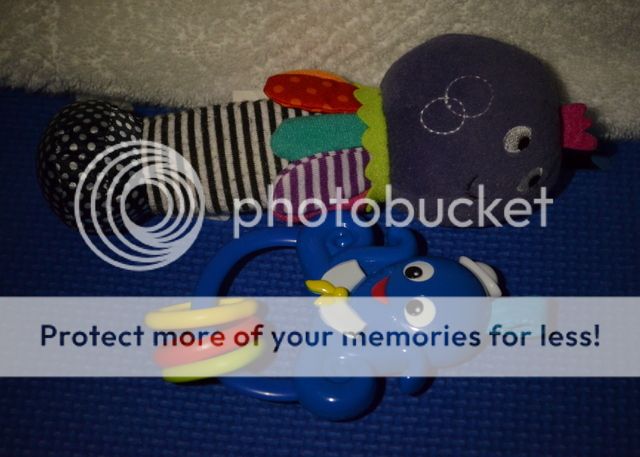
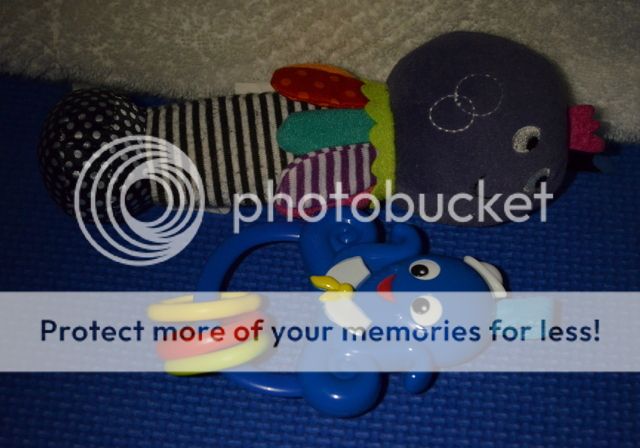
Levels/UI
The Firefly uses a very simple interface, with four levels. It always starts on low/moonlight (no mode memory) and increases levels with each half-press of the switch (reverse clicky). The light has a very short reset time (around ½ second) so getting back to moonlight is quick and easy. This is a very simple and intuitive interface. I found it to be very effective.
The four levels provide a wide range of output but the second level, after moonlight, should be lower for better visual spacing. As is, it is too visually close to the third level. This will be corrected in the production circuit.
The light is current controlled. No PWM is detected at any level.
Level estimates will follow shortly.
If one favours lower modes overall (like I do), nimh is the best choice. If one wants max output and is not too concerned about many lower levels, then 14500 cells are the best choice.
So, the circuit is a nice compromise. It offers a satisfyingly low moonlight mode with a potential 500+ lumen max mode. It's too bad that more of the lower modes aren't accessible with 14500 cells but one can only do so much with 4 levels.
Heat Management
When running on max using a 14500 cell, the light became uncomfortably hot after a couple minutes. It seems the copper heatsink is doing its job, even with the stainless steel body (notorious for poor heat conduction).
When running on max using a nimh battery, the light became warm but was never too hot to hold. The lower drive levels on nimh didn't generate too much heat.
Tritium Features
The Firefly has one very special feature: very large tritium locators. It is designed to be easily located in the dark and the eight, very large, glowing (2.5x10mm) tritium vials will ensure this. These are huge vials, making the light seem like a mini lantern. The vials will glow for more than 10-15 years without charging of any kind. The trits are striking and beautiful and now, thankfully, they can be practical.
The second prototype incorporates design changes that cushion the vials and also allow the user to change or remove them if desired. This is a significant improvement over the previous prototype (which was fragile and not user serviceable). Also, the firefly can be ordered with steel rods instead of tritium vials if ultimate durability is required (or lower cost, the tritium adds $100 to the cost of the light).
Very bright. Very beautiful. Now more practical!
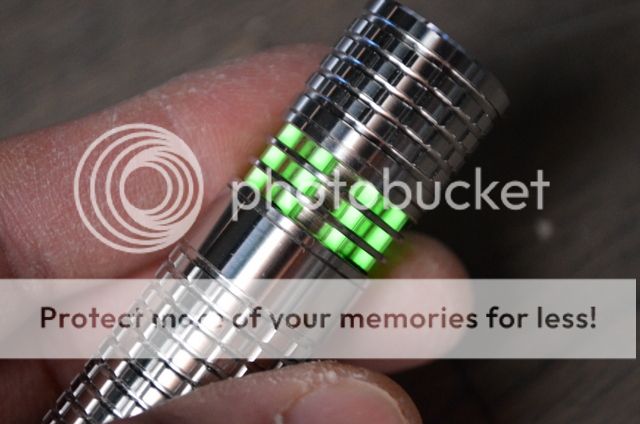
Drop Tests
I performed some quick drop tests to check for basic durability. The light was dropped three times from a height of three feet onto a hospital floor (linoleum over concrete) and three times on a hardwood floor. The light continued to function correctly, and no tritium vials were damaged. Still, for heavy use conditions, the steel rod option (instead of tritium) is recommended.
The Path to Kickstarter and Final Thoughts.
Overall, the second prototype is a marked improvement and is a great light. The host is well machined, the clip is strong and unique, the interface is simple and effective, and overall, it is a solid light.
The findings of this review have been passed on to the designer. He has been very responsive and will incorporate refinements and updates that will optimize this light for its release on Kickstarter.
I am looking forward to seeing the final finished product. It will undoubtedly be outstanding.
Portinga Products Firefly Second Prototype Review
Please note: This review will continue to evolve as I gather more data and pictures. I will continue adding to the review when possible. This prototype is stainless steel and utilizes a cool white XML2 LED. A titanium sample light (not a Firefly) has also been evaluated with the final production Nichia 219B (4000K colour temperature) LED. The final production Firefly will only be available in titanium.
This is a review of the second prototype of the Portinga Products Firefly flashlight, also known as the "Kickstarter Light". A sample was purchased for this review. No payment of any kind was accepted for the review.
Note: While this is considered a stand-alone review, large portions will be used from the review of the previous prototype, since many things have not changed.
The previous review can be found here:
http://www.candlepowerforums.com/vb...ype-Review-(the-quot-Kickstarter-light-quot-)
The current Kickstarter campaign can be found here:
https://www.kickstarter.com/project...ashlight-you-can-always-find-in-the?ref=users
More information on the creator, Josh Portinga, can be found here:
http://portingaproducts.com/
Summary
Overall, this is a an excellent light (prototype). The host is well machined with an innovative heatsink design for better heat shedding. The rectangular knurling is very grippy.
The milled clip is a work of art that clamps firmly and consistently.
The UI (User Interface) is simple and effective but a small adjustment in levels would improve the product (and is expected in the final production version).
The torch like tritium accents are both attractive and functional.
Here are some changes and improvements seen in the second prototype.
- The LED has been changed to cool white XML2 for increased output.
- The Tritium tubes are now cushioned to prevent damage. No damage was noted during drop testing.
- The new heatsink design allows one to easily change or remove the tritium tubes if desired.
- Various changes in the machining have been incorporated to increase waterproofing and improvement handling and feel (some sharp edges have been smoothed out).
There are a few more changes to be incorporated into the final production version.
- The final production light will be constructed of Grade 2 titanium.
- The knurling will be softened to reduce the aggressiveness, preventing damage to clothing and hands.
- The second light level will be reduced to around 50-70% of the current level to better improve visual spacing of the levels.
- There will be a choice of LEDs, either cool white XML2 for maximum output or 4000K Nichia 219B for best colour rendition and pleasing tint.
- The cool white LED will be changed to a slightly cooler bin with more output (expected CREE XML2, 1D tint (6500K) with U3 flux bin) when compared to this prototype.
- The reflector will be redesigned to achieve a more floody beam.
- The clip will be slimmer, incorporate new larger bolts, and the host will be threaded to properly secure the clip.
- Custom silicone caps will be produced to cushion the tritium tubes.
- Various construction enhancements (minor) will be incorporated into the final version.
The creator (Josh Portinga) has been very responsive and creative in improving the light. The Firefly (second prototype) is already very good. The final production version should be exceptional.
Background
A brief origin story. The Firefly came out of the unsuccessful electric eraser campaign.
https://www.kickstarter.com/projects/2112614854/precision-cnc-machined-304-stainless-steel-electri?ref=nav_search
While that project did not meet its funding goal, conversations with one of the backers prompted the creator (Josh Portinga) to develop a high-end custom flashlight. It was thought that flashlights were obsolete due to the prevalence of smart phones with built in lights.
Well, while a smart phone has many uses, it will always be a compromise. Those who desire top performance, utility, or style, will still buy high end devices: Watches, cameras, and of course, flashlights.
Thus was born the Firefly.
Host Quality
The machining on the host is impressive. The knurling is a rectangular pattern that is both attractive and uncommon. It is also very aggressive. The knurling ensures that one should be able to keep a firm grip on the light in all conditions. That said, the final version will have the knurling softened somewhat to reduce damage to clothes and skin while still providing ample grip.

Here are some views of the light with the clip installed. Note the temporary clip hardware. The final product will thread directly into holes in the host (unlike the prototype, no backing nuts will be needed).




Note that I also tested the firefly with an alternative aftermarket clip out of interest. My clip hardware was worn out after some use (the temporary hardware loosened frequently) so an alternative clip was used.

The threads were cut square and all pieces screwed together smoothly and precisely.
Here is the head partially disassembled. A nice, unique feature is that the LED thermal slug is soldered directly to the copper heatsink. This should promote great heat transfer to the host, keeping the LED nice and cool at high drive levels.

As you can see, the heatsink now incorporates a threaded brass ring that holds in the reflector in place. This ring allows the user to easily change or remove the tritium vials as needed. Please note the blue o-ring around the vials (for waterproofing).
Here is an alternate view with the ring removed from the head.

Here is a view of the heatsink with the brass ring and sealing o-ring in place.

Yes, that is an AR coated lens.

Overall, the host is very well put together and feels solid and hefty. Note that this prototype is stainless steel but the final production version will be constructed of Grade 2 titanium. Grade 2 titanium was chosen for its superior thermal conductivity.
Size-wise, the light is a comfortable 97x20mm. This should be considered a mid-size light, around the size of a many common AA lights (Fenix, Sunwayman, 4Sevens), but slimmer. It fits comfortably in the hand and is not too large to pocket.
This is the Firefly next to a Sunwayman M10A. Similar size to a Quark AA or Fenix equivalent.

And next to a few common AA lights. So, from L-R: Olight S15R, Eagletac D25A, Firefly, Zebralight SC52w, Eneloop bettery.

The switch boot cover is based on an uncommon size (10mm or so). I would have preferred a more standard size (14mm) but the switch worked well. The switch itself was a small Omten brand switch. They are reliable, easy to replace, and can handle high currents well (There are reports of usage up to 5 Amps). The switch is a reverse clicky, and the feel is firm and crisp.
Here it is next to a common 14mm boot. Note, the final production version will have a black boot.

Clip Quality
The clip is quite a marvel, being both beautiful and functional. It is my first experience with a milled clip. The alloy is 6-4 (AKA Grade 5) Titanium with fantastic characteristics. The clip is very springy and firm. The strength of the clip coupled with the aggressive knurling on the light will ensure that it will not slip out of your pocket. It may, however, chew up the fabric of your pants. Keep this in mind in use.
Cosmetically, the clip is very elegant and unique. I do find it a bit large/wide for the light, but that is a matter of taste. The hardware (bolts and nuts) that came with the clip were temporary and did not function well (they loosened up frequently and were too small to secure the clip reliably). Interesting, the clip continued to function well even with the existing hardware.
The final version of the clip will be bolted directly into the body of the light and larger bolts are being incorporated to increase strength and rigidity. Also, the clip will be made narrower to better suit the size of the light.
Here are a few views of the clip on a dummy light body.




Beam Characteristics
The beam is a mixed bag. The smooth reflector is designed for a very wide spill and achieves this goal. While, overall, the beam is quite clean, I find the transition from spot to spill a bit abrupt. It may help with throw somewhat but I find makes close range use a bit less pleasant. That said, the spot is somewhat wide (it's definitely not a thrower).
Note that the final production reflector will be redesigned to be more floody.
The cool white LED is well centered in the smooth reflector.

The beam is smooth but the hotspot is very distinct. Note that this is daylight colour balance but the beam is not quite that green in reality.

Here is a side profile of the beam.

Alternative LED Choices and Titanium Host Sample
The Firefly will be offered in one of two LED choices:
1. Cool White XML2 (6500K tint) for maximum output
2. High CRI Nichia 219B (4000K tint) for best colour rendering.
A Titanium host from the machinist (The Luckysun Ti20) was evaluated to gauge the quality of the machining in titanium (very good) and the tint of the Nichia 219B LED (Also very good). A few pictures follow of the host. Note that a diffusion film was used on the lens to isolate beam characteristics from tint.




LED Characteristics and Tint
Pictures were taken with a Nikon D5100 SLR using daylight white balance. I attempted to replicate beam characteristics and intensity as much as possible but was only somewhat successful.
All the lights will have diffusion films over the lens to isolate tint from beam characteristics.
Here are descriptions and pictures of the tints to be compared. Note that differences in the Nichia tints are very subtle and hard to capture in pictures.
Here are the tints all together, from coolest (on the left) to warmest.
They are (from L-R): 1D XML2, Nichia 219C (5000K), Nichia 219B (5000K), Nichia 219A (4500K), Nichia 219B (4000K)

- Cool White, 1D Tint XML2 (6500K), Firefly Sample. This tint is a touch warmer than expected. There are hints of yellow/green in the beam on a white wall that make it more pleasant in actual use. It is a bit stark and typical CRI is around 70, but this is expected for cool white; ideal for maximum output not colour accuracy. Note that the final production version will be cooler with a touch more output.

- High CRI Nichia 219B (4000K), Firefly Sample. This tint is the warmest and most pleasant (in my opinion) of all the Nichias. It has a light pink cast that really helps accentuate reds. My new favorite tint in a higher efficiency LED.

- High CRI Nichia 219A (4500K). This is still a very clean, crisp tint that has a light rose cast. It is very neutral and pleasant but the Nichia 219A is a bit dated and hence has lower efficiency and output.

- High CRI Nichia 219B (5000K). This has the same efficiency as the 4000K LED found in the Firefly. It is a touch cooler with more of a green cast.

- Neutral Nichia 219C (5000K). The 219C CRI is around 83 so not considered High CRI here (90+). This LED has a very low vF (Forward voltage) and can provide more output vs typical Nichia 219B LEDs. It has an even more greenish cast, and colours generally appear a bit flat when compared to the 219A/C. Note, that by itself, the tint is very pleasant but in comparison to the 219A/B LEDS, it has poorer colour rendition and is less pleasant.

Levels/UI
The Firefly uses a very simple interface, with four levels. It always starts on low/moonlight (no mode memory) and increases levels with each half-press of the switch (reverse clicky). The light has a very short reset time (around ½ second) so getting back to moonlight is quick and easy. This is a very simple and intuitive interface. I found it to be very effective.
The four levels provide a wide range of output but the second level, after moonlight, should be lower for better visual spacing. As is, it is too visually close to the third level. This will be corrected in the production circuit.
The light is current controlled. No PWM is detected at any level.
Level estimates will follow shortly.
If one favours lower modes overall (like I do), nimh is the best choice. If one wants max output and is not too concerned about many lower levels, then 14500 cells are the best choice.
So, the circuit is a nice compromise. It offers a satisfyingly low moonlight mode with a potential 500+ lumen max mode. It's too bad that more of the lower modes aren't accessible with 14500 cells but one can only do so much with 4 levels.
Heat Management
When running on max using a 14500 cell, the light became uncomfortably hot after a couple minutes. It seems the copper heatsink is doing its job, even with the stainless steel body (notorious for poor heat conduction).
When running on max using a nimh battery, the light became warm but was never too hot to hold. The lower drive levels on nimh didn't generate too much heat.
Tritium Features
The Firefly has one very special feature: very large tritium locators. It is designed to be easily located in the dark and the eight, very large, glowing (2.5x10mm) tritium vials will ensure this. These are huge vials, making the light seem like a mini lantern. The vials will glow for more than 10-15 years without charging of any kind. The trits are striking and beautiful and now, thankfully, they can be practical.
The second prototype incorporates design changes that cushion the vials and also allow the user to change or remove them if desired. This is a significant improvement over the previous prototype (which was fragile and not user serviceable). Also, the firefly can be ordered with steel rods instead of tritium vials if ultimate durability is required (or lower cost, the tritium adds $100 to the cost of the light).
Very bright. Very beautiful. Now more practical!

Drop Tests
I performed some quick drop tests to check for basic durability. The light was dropped three times from a height of three feet onto a hospital floor (linoleum over concrete) and three times on a hardwood floor. The light continued to function correctly, and no tritium vials were damaged. Still, for heavy use conditions, the steel rod option (instead of tritium) is recommended.
The Path to Kickstarter and Final Thoughts.
Overall, the second prototype is a marked improvement and is a great light. The host is well machined, the clip is strong and unique, the interface is simple and effective, and overall, it is a solid light.
The findings of this review have been passed on to the designer. He has been very responsive and will incorporate refinements and updates that will optimize this light for its release on Kickstarter.
- The light will be constructed of Grade 2 titanium.
- The knurling will be softened to reduce the aggressiveness, preventing damage to clothing and hands.
- The second light level will be reduced to around 50-70% of the current level to better improve visual spacing of the levels.
- There will be a choice of LEDs, either cool white XML2 for maximum output or 4000K Nichia 219B for best colour rendition and pleasing tint.
- The cool white LED will be changed to a slightly cooler bin with more output (expected CREE XML2, 1D tint (6500K) with U3 flux bin) when compared to this prototype.
- The reflector will be redesigned to achieve a more floody beam.
- The clip will be slimmer, incorporate new larger bolts, and the host will be threaded to properly secure the clip.
- Custom silicone caps will be produced to cushion the tritium tubes.
- Various construction enhancements (minor) will be incorporated into the final version.
I am looking forward to seeing the final finished product. It will undoubtedly be outstanding.
Last edited:

